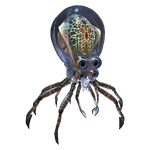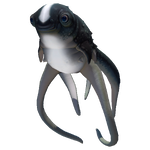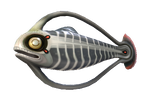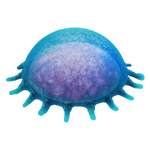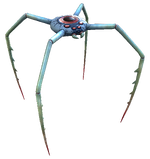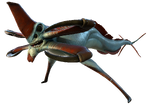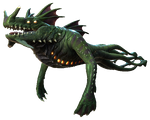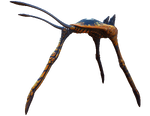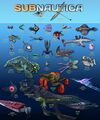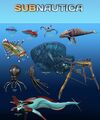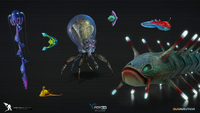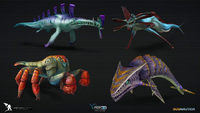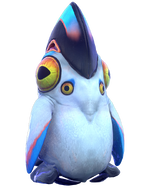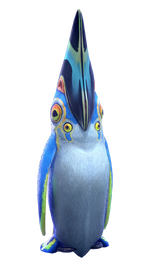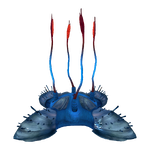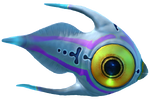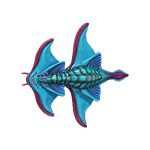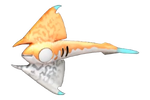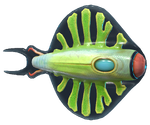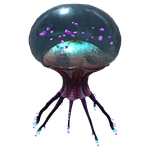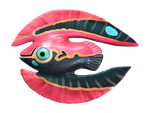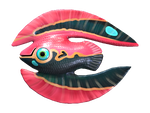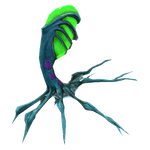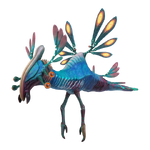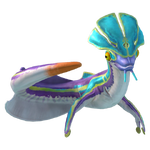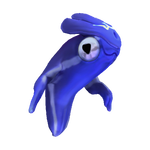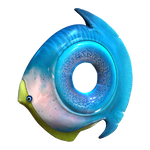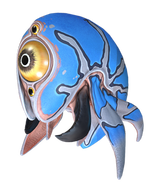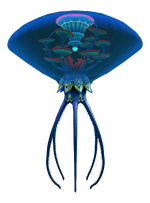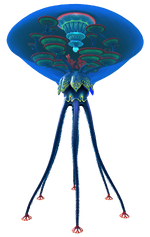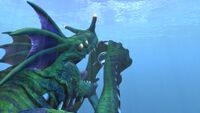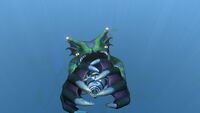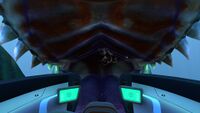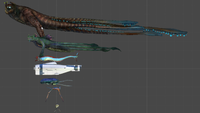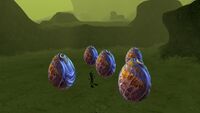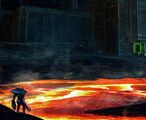User:GemmaBeepo

|
Read at own risk This article contains unmarked spoilers. Players new to the game would want to avoid or be cautious toward this article. |
Fauna is the term for animals, in this case, the animals of Planet 4546B. Fauna in Subnautica can be found all over the planet, from the mysterious depths of the Crystal Caves to the vibrant Safe Shallows, and the fiery pits of the Lava Lakes.
Fauna on Planet 4546B comes in all shapes, sizes, and forms. Ranging from the tiny, cave-dwelling Rockgrub, to the colossal Sea Dragon Leviathan that spews molten minerals from its mouth. Fauna on Planet 4546B is capable of enduring and adapting to various environments, although previously unable to thrive due to the presence of the Kharaa Bacterium. Certain species of small fauna can sometimes be seen forming mostly non-interactive shoals. Fauna on 4546B also has yellow blood. The fact that the appearance of some species of the planet being similar to that of planet Earth species can be explained as a simple case of convergent evolution.
The player can scan Fauna with the Scanner, the same as they would with Flora and objects, allowing them to view information about the creatures in their PDA.
In Subnautica additional scans after unlocking the Data Bank Entry for that particular species of Fauna alert the player as to whether or not the specimen is infected with Kharaa. As Kharaa has been eliminated from the wild in Below Zero this function is not present.
Reproduction
Most known fauna species on Planet 4546B are simultaneous hermaphrodites, meaning that they have a single-sex capable of playing the role of either the male or female in reproduction and every individual being able to lay eggs and fertilize them. Two parents are still required to fertilize the eggs once laid, making it sexual reproduction. At least one fauna species is exempt from this and reproduces entirely asexually, although the norm for the planet is sexual reproduction, as can be observed in all species that can be placed in an Alien Containment unit who will require two individuals of their species to produce eggs. The only species that does not reproduce is the Warper due as they are artificial fauna.
The only one of the complex fauna species on the planet known to be an exception to this rule is the Sea Emperor Leviathan species, which is entirely asexual and does not require a mate. The Sea Dragon Leviathan may share this method of reproduction as it is likely the closest living relative of the Sea Emperor Leviathan and was being studied by the Precursor Race to learn more about the Sea Emperor's reproduction.
Fauna of The Crater
Carnivores
| Fauna | Attitude | Biome |
|---|---|---|
| Ampeel |
Aggressive |
|
| Biter |
Aggressive |
|
| Blighter |
Aggressive |
|
| Boneshark |
Aggressive |
|
| Crabsnake |
Aggressive |
|
| Crabsquid |
Aggressive |
|
| Crashfish |
Aggressive |
|
| Lava Lizard |
Aggressive |
|
| Mesmer |
Aggressive |
|
| River Prowler |
Aggressive |
|
| Sand Shark |
Aggressive |
|
| Stalker |
Aggressive |
|
| Warper |
Aggressive |
Herbivores
| Fauna | Attitude | Biome |
|---|---|---|
| Bladderfish |
Passive |
|
| Boomerang |
Passive |
|
| Crimson Ray |
Passive |
|
| Cuddlefish |
Passive |
|
| Eyeye |
Passive |
|
| Garryfish |
Passive |
|
| Gasopod |
Passive |
|
| Ghostray |
Passive |
|
| Holefish | ||
| Hoopfish |
Passive |
|
| Hoverfish |
Passive |
|
| Jellyray |
Passive |
|
| Magmarang |
Passive |
|
| Oculus |
Passive |
|
| Peeper |
Passive |
|
| Rabbit Ray |
Passive |
|
| Red Eyeye |
Passive |
|
| Reginald |
Passive |
|
| Skyray |
Passive |
|
| Spadefish |
Passive |
|
| Spinefish |
Passive |
Scavengers and Parasites
| Fauna | Attitude | Biome |
|---|---|---|
| Amoeboid |
Passive |
|
| Ancient Floater |
Passive |
|
| Bleeder |
Aggressive |
|
| Blood Crawler |
Aggressive |
|
| Cave Crawler |
Aggressive |
|
| Floater |
Passive |
|
| Lava Larva |
Passive |
|
| Rockgrub |
Passive |
|
| Shuttlebug |
Passive |
Leviathan Class
| Fauna | Attitude | Biome |
|---|---|---|
| Ghost Leviathan |
Aggressive |
|
| Ghost Leviathan Juvenile |
Aggressive |
|
| Reaper Leviathan |
Aggressive |
|
| Reefback Leviathan |
Passive |
|
| Reefback Leviathan Juvenile |
Passive |
|
| Sea Dragon Leviathan |
Aggressive |
|
| Sea Emperor Leviathan |
Passive |
|
| Sea Emperor Leviathan Baby |
Passive |
|
| Sea Emperor Leviathan Juvenile |
Passive |
|
| Sea Treader Leviathan |
Defensive |
Extinct Species
| Species | Location of Remains | Age |
|---|---|---|
| Alpha Peeper Species |
|
Unknown |
| Alpha Ray Species |
|
Unknown |
| Ancient Skeleton |
~1,000,000 years | |
| Gargantuan Fossil |
~3,000,000 years | |
| Research Specimen Theta |
~1000 years |
Gallery
Fauna of Sector Zero
Carnivores
| Fauna | Attitude | Biome |
|---|---|---|
| Brinewing |
Aggressive |
|
| Brute Shark |
Aggressive |
|
| Crashfish |
Defensive |
|
| Cryptosuchus |
Aggressive |
|
| Noot Fish |
Passive |
|
| Pengling |
Passive |
|
| Pengwing |
Defensive |
|
| Pinnacarid |
Passive |
|
| Rock Puncher |
Aggressive |
|
| Snow Stalker |
Aggressive |
|
| Snow Stalker Baby |
Passive |
|
| Spikey Trap |
Aggressive |
|
| Squidshark |
Aggressive |
|
| Symbiote |
Aggressive |
Herbivores
| Fauna | Attitude | Biome |
|---|---|---|
| Arctic Peeper |
Passive |
|
| Arctic Ray |
Passive |
|
| Arrow Ray |
Passive |
|
| Bladderfish |
Passive |
|
| Boomerang |
Passive |
|
| Discus Fish |
Passive |
|
| Eye Jelly |
Defensive |
|
| Feather Fish |
Passive |
|
| Red Feather Fish |
Passive |
|
| Hivemind |
Passive |
|
| Hoopfish |
Passive |
|
| Lily Paddler |
Defensive |
|
| Sea Monkey |
Passive |
|
| Sea Monkey Baby |
Passive |
|
| Skyray |
Passive |
|
| Spinefish |
Passive |
|
| Spinner Fish |
Passive |
|
| Titan Holefish |
Passive |
|
| Triops |
Passive |
|
| Trivalve |
Passive |
|
Scavengers & Parasites
| Fauna | Attitude | Biome |
|---|---|---|
| Rockgrub |
Passive |
Leviathans
| Fauna | Attitude | Biome |
|---|---|---|
| Chelicerate |
Aggressive |
|
| Glow Whale |
Passive |
|
| Ice Worm |
Aggressive |
|
| Juvenile Ventgarden |
Passive |
|
| Shadow Leviathan |
Aggressive |
|
| Ventgarden |
Passive |
|
| Void Chelicerate |
Aggressive |
Extinct Species
| Fauna | Location of Remains | Age |
|---|---|---|
| Frozen Leviathan |
~1000 years at most |
Trivia
- As of the Dangerous Creatures update, all fauna have yellow blood. Before this update, all fauna had red blood. This is due to the ESRB giving Subnautica a higher rating than expected due to red blood.
- Scientifically speaking, the fauna of planet 4546B might have high concentrations of vanabin in their blood.
- Fauna were once intended to possess inherent attributes, that would have caused them to exhibit unique behaviors. These included, e.g., "Fertile" (occasionally lay eggs that can be hatched), "Alpha" (attacked the player if other creatures were killed by the player in the immediate vicinity), "Complex" (specimens take longer to scan), "Greater" (specimens are of larger size and weight). This, however, was scrapped upon the final release.
- The spawn ID of the Blood Crawler is shuttlebug, and the spawn ID for the Shuttlebug is jumper, likely referring to the Blood Crawler. It is unknown why these two are reversed.
- In the very early stages of Subnautica, there were many unused and cut fauna.
- An unused creature named the Sandworm could only be found in the Entity Gallery. It was intended to stay in one place under the ground, and when the player or an NPC was right above it, it would spring up and would do 1 damage at a very fast rate. It only had animations for shooting out of the ground, going back into its hole, and an idle animation.
- The unused Grabcrab creature would leave its burrow and search for items to drag back to its hole. These items included small resources and even small fish. Its burrow also had the same model as the Grabcrab.
- Unused clusters of Bloom Plankton can be spawned in the game, and react to light. They will glow red if a Flare is shining on them, and white if a Flashlight or Vehicle's light is shining on them.
- In the Early Access Release trailer, the Large Bird can be seen flying among the Skyrays. They were cut entirely out of the game sometime before Early Access, making their appearance in the trailer the last time they were seen.
Flora of The Crater
Flora of Sector Zero
Coral of The Crater
Coral of Sector Zero






